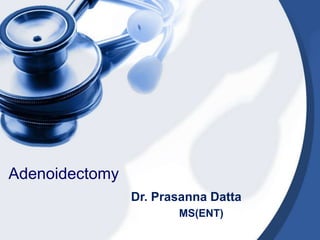
Adenoidectomy
- 3. X-Ray Nasopharynx enlarged adenoids
- 4. • Adenoidectomy may be indicated alone or in combination with tonsillectomy. In the latter event, adenoids are removed first and the nasopharynx packed before starting tonsillectomy
- 5. Indications • 1. Adenoid hypertrophy causing snoring, mouth breathing, sleep apnoea syndrome or speech abnormalities, i.e. (rhinolalia clausa). • 2. Recurrent rhinosinusitis. • 3. Chronic secretory otitis media associated with adenoid hyperplasia.
- 6. Indications cont.. • 4. Recurrent ear discharge in benign CSOM associated with adenoiditis/adenoid hyperplasia. • 5. Dental malocclusion. Adenoidectomy does not correct dental abnormalities but will prevent its recurrence after orthodontic treatment.
- 7. Contraindications • 1. Cleft palate or submucous palate. Removal of adenoids causes velopharyngeal insufficiency in such cases. • 2. Haemorrhagic diathesis. • 3. Acute infection of upper respiratory tract.
- 8. Anaesthesia • Always general, with oral endotracheal intubation.
- 9. Position • Rose's position, i.e. patient lies supine with head extended by placing a pillow under the shoulders. In this position both the head and neck are extended.
- 10. Rose's position for adenoidectomy. Neck is extended by a sand bag under the shoulders and the head is supported on a ring. Downloaded from: StudentConsult (on 6 December 2012 06:54 PM) © 2005 Elsevier Rose's position
- 11. Steps of Operation • 1. Boyle-Davis mouth-gag is inserted. Before actual removal of adenoids, nasopharynx should always be examined by retracting the soft palate with curved end of the tongue depressor and by digital palpation, to confirm the diagnosis, to assess the size of adenoids mass and to push the lateral adenoid masses towards the midline.
- 12. • 2. Proper size of "adenoid curette with guard" is introduced into the nasopharynx till its free edge touches the posterior border of nasal septum and is then pressed backwards to engage the adenoids. At this level, head should be slightly flexed to avoid injury to the odontoid process.
- 13. Adenoid curette with guard Without guard
- 14. • 3. With gentle sweeping movement, adenoids are shaved off . Lateral masses are similarly removed with smaller curettes; small tags of lymphoid tissue left behind are removed with punch forceps. • 4. Haemostasis is achieved by packing the area for sometime. Persistent bleeders are electrocoagulated under vision. If bleeding is still not controlled, a postnasal pack is left for 24 hours
- 15. Adenoidectomy.
- 16. Endoscopic Adenoidectomy • These days adenoids can be removed more precisely by using a debrider under endoscopic control
- 17. Nasal endoscopic adenoidectomy using curette
- 18. Oral endoscopic adenoidectomy using curette
- 19. micro debrider micro debrider micro debrider-tip blade
- 21. Adenoidectomy using oral 70 degree endoscope
- 23. After removal of adenoids
- 25. Coblation adenoidectomy • It is also other wise known as cold abalation. This technique utilises a field of plasma, or ionised sodium molecules, to ablate tissues. The heat generated varies from 40 - 80 degrees centigrade, much lower than that of electro cautery. The major advantage of this procedure is reduced bleeding and reduced post operative pain.
- 28. Post-operative Care 1. Immediate general care (a)Keep the patient in coma position until fully recovered from anaesthesia. (b)Keep a watch on bleeding from the nose and mouth. (c)Keep check on vital signs, e.g. pulse, respiration and blood pressure.
- 29. Post-operative Care cont.. 2. Diet When patient is fully recovered he is to take liquids, e.g. cold milk or ice cream. 3. Nasal saline drops
- 30. Post-operative Care cont.. 4. Analgesics Pain, locally in the throat and referred to ear, can be relieved by analgesics like paracetamol. There is no dysphagia and patient is up and about early. 5.Antibiotics A suitable antibiotic can be giv en orally or by injection for a week. Patient is usually sent home 24 hours after operation unless there is some complication. Patient can resume his normal duties within 2 weeks
- 31. Complications • 1. Haemorrhage, usually seen in immediate post-operative period. Nose and mouth may be full of blood or the only indication may be vomitus of dark- coloured blood which the patient had been swallowing gradually in post-operative period. Rising pulse rate is another indicator. Treatment is same as for per- operative haemorrhage. Postnasal pack under general anaesthesia is often required. • 2. Injury to eustachian tube opening.
- 32. • 3. Injury to pharyngeal musculature and vertebrae. This is due to hyperextension of neck and undue pressure of curette. Care should be taken when operating patients of Down's syndrome as 10-20% of them have atlanto-axial instability. • 4. Griesel syndrome. Patient complains of neck pain and develops torticollis. Mostly it is due to spasm of paraspinal muscles, but can be due to atlanto-axial dislocation requiring cervical collar and even traction.
- 33. • 5. Velopharyngeal insufficiency. It is necessary to check for submucous cleft palate by inspection and palpation before removal of adenoids. • 6. Nasopharyngeal stenosis due to scarring. • 7. Recurrence. This is due to regrowth of adenoid tissue left behind.
- 34. Thank You